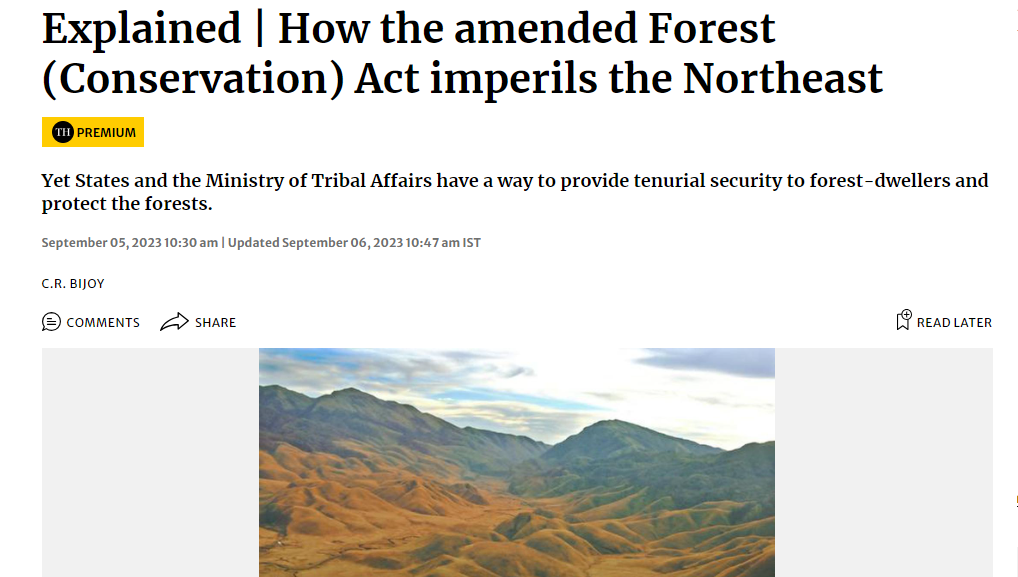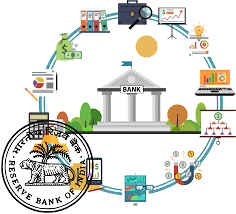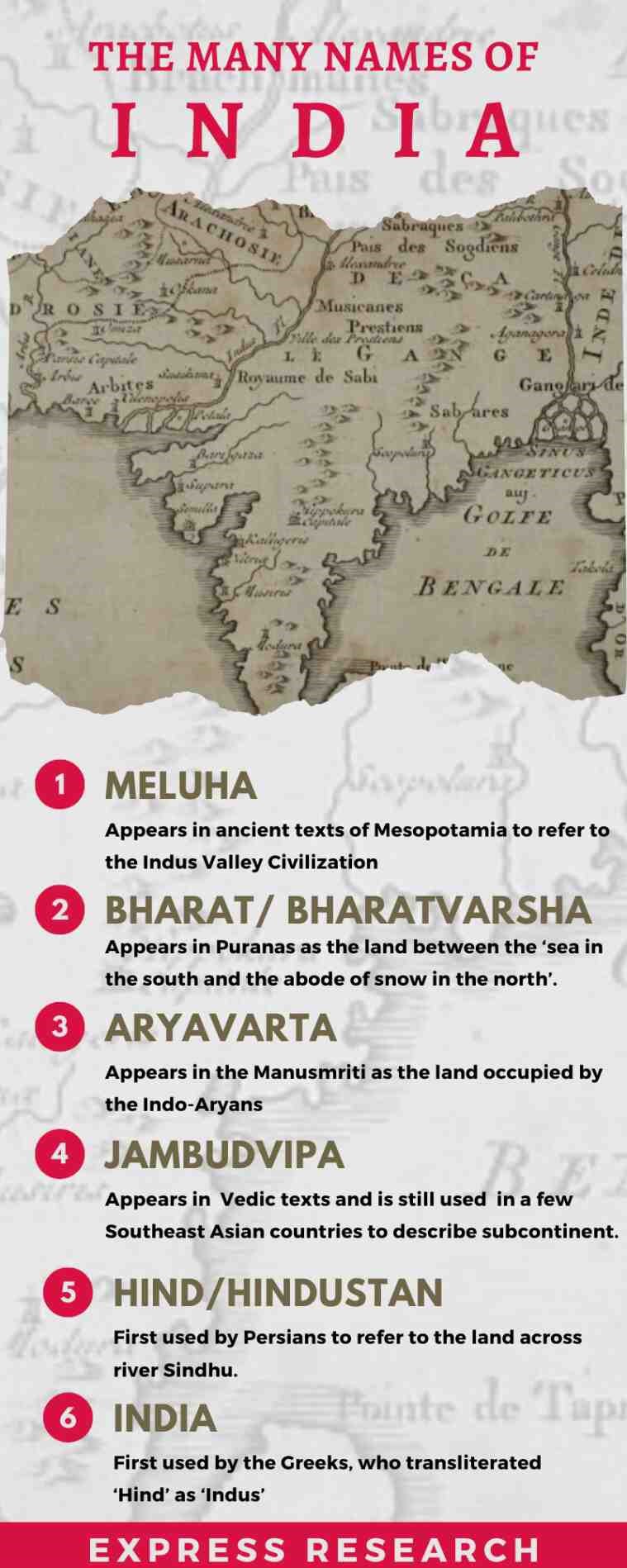Topics:
1. Strengthening export control measures for Dual-Use Items
2. Laws governing forests of Northeast India
3. Urban Cooperative Banks (UCBs): Concerns and Considerations
4. Gramodyog Vikas yojana
5. History of India’s name
STRENGTHENING EXPORT CONTROL MEASURES FOR DUAL-USE ITEMS
Context:
- The government has expressed its commitment to strengthening control over dual-use items to prevent their misuse by non-state actors and terrorists.
- Dual-use items are goods that can serve both civilian and military purposes, and this commitment aims to ensure responsible trade and global non-proliferation efforts.
Understanding Dual-Use Items
- Dual-use items have applications in both civilian and military contexts and can be repurposed for military or terrorist activities.
- Examples include global positioning satellites, missiles, nuclear technology, chemical and biological weapons, night vision technology, and specific drones, among others.
Control Mechanisms for Dual-Use Items
- International Cooperation: Many industrialized nations have established export controls on designated dual-use technologies.
- Multilateral Agreements: Various international treaties and agreements govern the export of dual-use items.
- India’s Participation: India is a signatory to major multilateral export control regimes such as MTCR, WA, AG, NSG, and conventions like CWC and BWC.
- DGFT’s Role: In India, the DGFT regulates dual-use items through the SCOMET List (Specialty Chemicals, Organisms, Materials, Equipment, and Technologies).
What is the SCOMET List?
- SCOMET items are dual-use items that can be used for civilian and military applications.
- India’s Foreign Trade Policy regulates their export, and they may require a license for export.
- The SCOMET List aligns with the control lists of various multilateral export control regimes and conventions.
Necessity of Controlling Dual-Use Items
- India’s Commitment: India is firmly committed to non-proliferation efforts related to dual-use items.
- Integral Component: Export control over these items is integral to India’s broader export control system.
- Compliance: It ensures compliance with international regimes, such as MTCR, in the trade of sensitive and dual-use goods.
Conclusion
- The government’s commitment to enhancing export control measures for dual-use items demonstrates dedication to global non-proliferation efforts and responsible technology trade.
Collaborative efforts among governments, industries, and stakeholders are essential for effective export control of these items.
LAWS GOVERNING FORESTS OF NORTHEAST INDIA
Context
The Mizoram Assembly has passed a resolution opposing the Forest (Conservation) Amendment Act, 2023, with the aim of safeguarding the rights and interests of the people of Mizoram.
This amendment allows for the diversion of forest land for specific projects near international borders without the need for forest clearance under the Forest (Conservation) Act (FCA) 1980.
Why Discuss This?
- Regional Opposition: Several northeastern states, including Nagaland, Tripura, Mizoram, and Sikkim, which are governed by the ruling government at the center or its allies, have raised objections to the 100-kilometer exemption clause in the Forest (Conservation) Amendment Act, 2023.
- Constitutional Protections: Some northeastern states, like Nagaland and Mizoram, benefit from constitutional protections such as Article 371A and Article 371G, which limit the application of certain laws enacted by Parliament in these states.
- FCA Application: The application of the Forest (Conservation) Act varies among northeastern states, with Mizoram having it in force since becoming a state in 1986, covering a significant portion of its forest areas.
FCA Application in the Rest of the Northeast
- The Forest (Conservation) Act is applicable in the rest of the northeastern states, including Meghalaya, Tripura, Assam, Manipur, Sikkim, and Arunachal Pradesh.
- However, the clearance process for forest diversion differs among these states.
Recorded Forest Area (RFA) and Unclassed Forests
- RFA Variability: The recorded forest area (RFA) varies significantly among northeastern states, ranging from 34.21% in Assam to 82.31% in Sikkim.
- Unclassed Forests: Unclassed forests, which make up a significant portion of northeastern forests, are prevalent, ranging from nil in Sikkim to 97.29% in Nagaland.
About Forest Rights Act (FRA)
- The Forest Rights Act (FRA) recognizes the rights of traditional forest dwellers and extends to unclassed forests.
- However, the implementation of the FRA varies among northeastern states, with Assam and Tripura being notable exceptions.
- The FRA can provide legal security to community tenurial rights over forests.
Challenges in FRA Implementation
- Incomplete Implementation: Many northeastern states have not fully implemented the FRA, often due to the perception that it is irrelevant because of existing land ownership patterns and a lack of forest-dependent communities.
- Mizoram’s Stand: Mizoram, despite initially adopting the FRA, later declared it as irrelevant to the state.
Protecting Forests
- To protect northeastern forests, measures can be formulated to ensure mandatory FRA compliance before recommending forest diversion proposals.
- It is crucial to obtain the consent of the Gram Sabha (village assembly) before transferring forest land.
- The Ministry of Tribal Affairs can issue legally enforceable directions under the FRA to protect forest rights when forests are diverted for other purposes, particularly during relocations.
Conclusion
Safeguarding northeastern forests necessitates striking a balance between legal frameworks like the FCA and FRA.
Clear guidelines and proactive measures are essential to ensure the protection of both forest rights and the environment in the region.
This issue underscores the need for careful consideration of the delicate ecological and socio-cultural balance in northeastern India.
Urban Cooperative Banks (UCBs): Concerns and Considerations
Context
- The Reserve Bank of India (RBI) Governor recently emphasized the significance of addressing issues and vulnerabilities within Urban Cooperative Banks (UCBs) to ensure the stability and resilience of the banking sector.
What are Urban Cooperative Banks (UCBs)?
- UCBs are primary cooperative banks primarily located in urban and semi-urban areas, serving the financial needs of small borrowers and businesses.
- They operate under the regulatory framework of the Banking Regulations Act, 1949, the Banking Laws (Cooperative Societies) Act, 1955, and are registered under the Cooperative Societies Act of their respective states.
- Initially limited to non-agricultural lending, they have expanded their scope since 1996. Approximately 79% of UCBs are concentrated in five states: Andhra Pradesh, Gujarat, Karnataka, Maharashtra, and Tamil Nadu.
Types of UCBs
UCBs are categorized into different tiers by the RBI based on their deposit size:
- Tier 1: Deposits up to Rs 100 crore.
- Tier 2: Deposits ranging from Rs 100 to 1,000 crore.
- Tier 3: Deposits between Rs 1,000 to Rs 10,000 crore.
- Tier 4: Deposits exceeding Rs 10,000 crore.
Key Concerns/Addresses Raised by RBI
- Operational Stability
UCBs need to bolster their financial and operational resilience to contribute to overall financial sector stability. The quality of governance within these banks is crucial for their individual stability.
- Setting up Right Priorities
- Boards and directors of UCBs must prioritize integrity and transparency in financial reporting and avoid innovative accounting practices that obscure the true financial position.
- Proactive management of Asset Liability is vital for systematic liquidity risk management.
- Developing robust IT and cybersecurity infrastructure, along with relevant skills, is essential.
- Governance practices, particularly in Compliance, Risk Management, and Internal Audit, require strengthening.
- Functioning of Boards
- Ensuring directors possess adequate skills and expertise, forming a professional board of management, considering diversity and tenure of board members, promoting transparent and participatory board discussions, and ensuring the effective functioning of board-level
- Credit Risk Management
- UCBs must uphold risk management through robust underwriting standards, implement effective post-sanction monitoring, promptly recognize and mitigate emerging stress, and actively pursue follow-ups with large Non-Performing Asset (NPA) borrowers to facilitate recovery and maintain adequate provisioning.
Conclusion
- Addressing concerns and vulnerabilities in Urban Cooperative Banks is vital for the overall stability and resilience of the banking sector.
- The RBI’s recommendations underscore the significance of governance, risk management, and transparency in ensuring the health and sustainability of UCBs.
It is imperative that UCBs prioritize these aspects to maintain their operational stability and contribute positively to the broader financial system.
GRAMODYOG VIKAS YOJANA
Context:
Recently, the Chairman of the Khadi and Village Industries Commission (KVIC), Ministry of Micro, Small and Medium Enterprises, distributed tool-kits and machinery to artisans under the ‘Gramodyog Vikas Yojna’.
Gramodyog Vikas Yojana:
- Launched: In March 2020
- Aim: To promote and develop village industries through common facilities, technological modernization, training, etc.
Components of the Yojana:
- Research & Development and Product Innovation:
- Supporting research and development efforts for product enhancement, novel innovations, design evolution, and product diversification by eligible institutions.
- Capacity Building:
- Focusing on the development of skills and expertise among staff and artisans through the existing MDTCs (Micro, Small, and Medium Enterprises – Development and Training Centers) and institutions of excellence.
- Marketing & Publicity:
- Assisting village industry institutions with market-related endeavors such as creating product catalogs, industry directories, conducting market research, employing new marketing techniques, organizing buyer-seller meetings, and arranging exhibitions.
- Targeted beneficiaries: Artisans, unemployed youth, and self-help groups (SHGs).
- Eligibility requirements: Individuals who qualify as Traditional Artisans and possess skills and experience in the field of Art and Craft are eligible to participate in this initiative.
Khadi and Village Industries Commission (KVIC):
- Establishment: It is a statutory body established under the Khadi and Village Industries Commission Act, 1956.
- Nodal Ministry: Ministry of Micro, Small and Medium Enterprises.
Responsibilities: The KVIC is responsible for strategizing, advocating, and overseeing programs aimed at the growth of Khadi and rural industries in rural areas. This includes planning and implementation, working in collaboration with other relevant agencies involved in rural development when required.
HISTORY OF INDIA’S NAME
Context:
A political dispute emerged when the government sent a G20 Summit dinner invitation addressed to the “President of Bharat” instead of the “President of India.”
Historical and Cultural Roots of “Bharat”
- Ancient Times – Bharat, Bharata, Bharatvarsha: The name “Bharat” has ancient origins in Puranic literature and the Mahabharata epic, describing the subcontinent’s boundaries.
- Saindhav Pradesh: In ancient times, India was referred to as “Saindhav Pradesh” due to its association with the Sindhu (Indus) River.
- Supraregional and Subcontinental Territory: “Bharat” symbolizes a religious and socio-cultural entity, signifying the territory where the Brahmanical system of society prevails.
- Ancient King Bharata: “Bharata” is linked to an ancient legendary king and the Rig Vedic tribe of the Bharatas, considered the progenitors of the subcontinent’s people.
Evolution of “Hindustan” and “India” Names
- Introduction of “Hindustan”: “Hindustan” likely originated from the Persian “Hindu,” referring to the Indus River, during the Achaemenid Persian conquest.
- Transliteration to “India“: The Greeks transliterated “Hind” as “Indus,” associating “India” with the region beyond the Indus River.
- Usage of “Hindustan” and Expansion: In the early Mughal period, “Hindustan” referred to the Indo-Gangetic plain, including the Mughal territories.
- Transition to “India”: British colonial maps increasingly adopted the name “India” from the late 18th century onwards, replacing “Hindustan.”
Constitutional Naming and Dual Nomenclature
- Inclusion in the Constitution: The Indian Constitution retained both “Bharat” and “India” as names for the nation. Debates in the Constituent Assembly considered alternatives but settled on this dual nomenclature.
- Constitutional Naming: The first article of the Indian Constitution states, “India, that is Bharat, shall be a Union of States,” reflecting the coexistence of both names.
Evolution of the English Name “India”
- Herodotus and Byzantines (Ancient Times): Byzantines used ‘India’ for the region beyond the Indus River, influenced by Herodotus’ works.
- King Alfred’s Translation (9th Century): The English name ‘India’ derived from Latin and appeared in King Alfred’s translation of Orosius in Old English, though it later changed due to French influence.
- Reintroduction of ‘India’ (Late Early Modern English, 15th Century to 1650 AD): ‘India’ re-emerged in the English language, influenced by Latin, Spanish, or Portuguese, and was reintroduced during this period.
This dispute highlights the rich historical and cultural complexity of India’s name, rooted in ancient times, and the constitutional recognition of both “Bharat” and “India.” The choice of name continues to hold significance and can be a source of political discourse.





